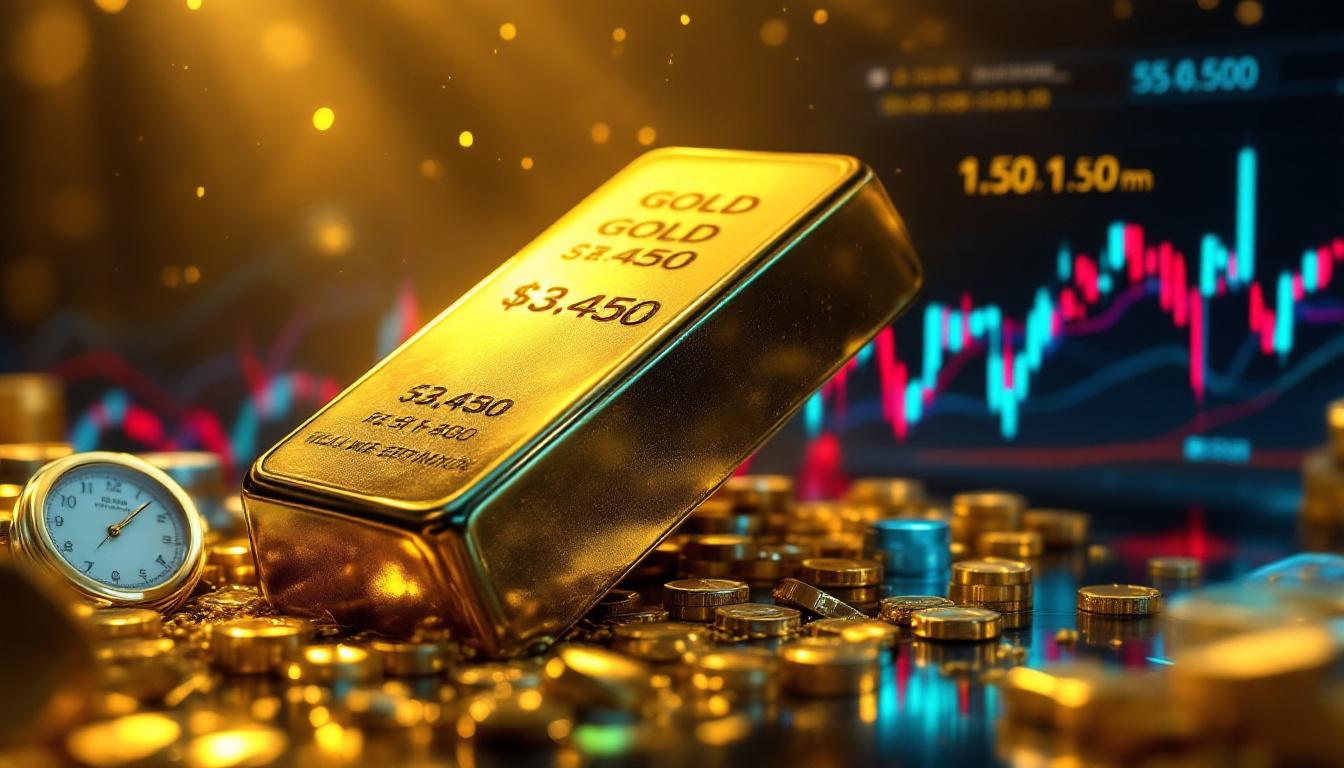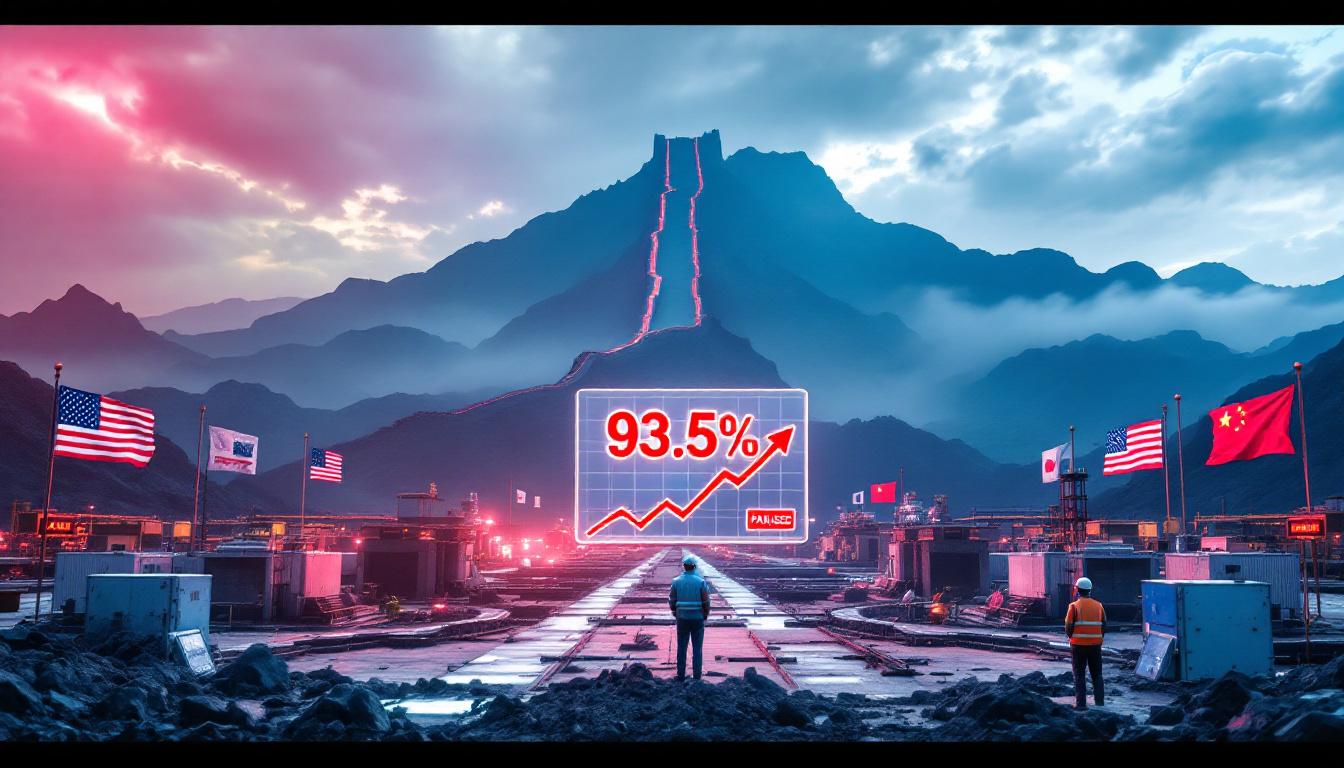How Are Trump's Tariff Proposals Affecting Copper Markets?
The copper market has experienced unprecedented volatility following Trump's recent tariff announcements, creating market dynamics rarely seen in commodity trading. What started as speculation quickly transformed into dramatic price action when details emerged that raw materials—specifically copper cathodes and ores—would be excluded from the proposed tariffs.
"The spread between US traded CME copper and LME copper at 30% just a few days ago reached the highest ever and now it's back at par," explains Mike McGlone, Senior Commodity Strategist at Bloomberg Intelligence. This extreme divergence between the two major copper benchmarks highlights the market's sensitivity to policy shifts and the rapid repricing that occurred once traders absorbed the full implications of the tariff exclusions.
Currently trading at approximately $4.35 per pound, copper prices remain significantly elevated compared to historical averages, despite retreating from the recent peak of $4.96 per pound reached earlier this month. This price level represents a premium that appears increasingly difficult to sustain given underlying economic fundamentals.
Understanding the Recent Market Shock
The copper market's reaction to Trump tariffs on copper mirrors the behavior of markets facing sudden regulatory shifts. Initially, traders positioned for blanket tariffs that would impact all forms of copper imports. When clarification came that raw materials would be excluded, rapid unwinding of positions created extreme price dislocations across global copper exchanges.
This market behavior demonstrates how policy announcements can create temporary arbitrage opportunities that quickly normalize once information is fully incorporated. The unprecedented 30% gap between US-traded CME copper and LME copper prices represented one of the most extreme dislocations in the history of industrial metals trading.
"Copper has a normal tendency to autocorrelate towards $3 a pound," notes McGlone, highlighting the metal's historical tendency to revert to mean prices regardless of short-term disruptions.
The current price level of $4.35 per pound represents a significant premium above this historical mean, suggesting potential downside risk as markets continue to digest policy implications and adjust to changing economic conditions.
The Unusual Market Dynamics at Play
The recent copper price spike to $4.96 per pound bears striking similarities to other commodity market extremes, such as the July 2008 crude oil surge to $147 per barrel just before a major market correction. These parallels suggest caution may be warranted for copper investment insights and industrial consumers alike.
Extreme price moves in commodity markets often signal potential reversals rather than sustainable trends. When prices detach dramatically from underlying fundamentals, market mechanics typically drive eventual corrections. In copper's case, several factors suggest the current premium may be difficult to maintain:
- Global economic growth headwinds creating demand concerns
- Technical resistance at key price levels above $9,600 per ton
- Historical tendency to revert toward mean prices around $3 per pound
- Supply elasticity that typically responds to sustained high prices
London copper currently trades around $9,600 per ton, approaching the highest yearly close of $9,800 seen in 2021. Technical analysis suggests a risk of retracement toward $8,000 per ton if current market conditions persist, representing a significant potential correction from current levels.
What's Driving Gold's Performance in the Current Economy?
Gold has emerged as one of the standout performers in 2024, delivering impressive returns against a backdrop of persistent inflation and growing economic uncertainty. Currently trading around $3,300 per ounce, gold has been consolidating in what technical analysts describe as a "bull flag" pattern for approximately four months, potentially setting the stage for further advances.
"Gold being one of the best performing major assets this year in terms of US dollars is figuring out the silliness of markets," observes McGlone, highlighting the metal's role as a barometer for broader market distortions.
Gold's Resilience Amid Economic Uncertainty
The precious metal's performance gains additional significance when viewed through the lens of investor behavior. Gold ETF holdings have increased approximately 10% this year, marking a decisive reversal after four consecutive years of outflows. This shift in investment patterns signals growing investor concern about traditional financial assets and heightened demand for perceived safe-haven alternatives.
Gold prices analysis shows that supply dynamics further support its price resilience. Unlike many commodities that can rapidly increase production in response to higher prices, gold mining faces significant constraints:
- Long lead times for new mine development (typically 5-10 years)
- Declining ore grades requiring more intensive extraction methods
- Geopolitical complications affecting major producing regions
- Environmental permitting challenges limiting new project approvals
These supply constraints create a relatively inelastic response to price increases, allowing demand shifts to translate more directly into sustained price movements compared to many industrial commodities.
Gold vs. Traditional Investment Vehicles
Perhaps most telling is gold's performance relative to traditional investment benchmarks. The gold-to-S&P 500 ratio currently stands at 0.52 ounces, potentially heading toward its highest year-end level since 2015. This metric provides a valuable perspective on relative value between productive assets (stocks) and monetary metals.
"Gold versus a flat S&P 500 if you don't include earnings is the same for almost 10 years now," McGlone points out, challenging conventional wisdom about opportunity costs associated with holding non-yielding assets during periods of rising equity markets.
This performance parity becomes particularly significant in an environment where concerns about equity valuations are increasing. Gold's historical tendency to perform well during periods of market stress positions it as a potential beneficiary if current equity market valuations prove unsustainable.
Central bank purchasing, while moderating from recent peaks, continues to provide underlying support for gold prices. The diversification of sovereign reserves away from traditional currencies represents a structural shift in global monetary preferences that appears likely to persist.
How Are Federal Reserve Policies Influencing Commodity Markets?
The Federal Reserve's recent decision to maintain steady interest rates while signaling continued caution regarding inflation targets has created an unusual environment for commodity markets. This policy stance has contributed to divergent performance across different commodity classes, with monetary metals outperforming many industrial commodities.
"That's not an environment to ease, it's an environment to tighten. But to me, that's what gold likes," observes McGlone, highlighting the contradiction between conventional monetary policy expectations and current Fed positioning.
The Fed's Cautious Stance
Traditional economic theory suggests that persistent above-target inflation combined with strong equity markets would typically warrant monetary tightening rather than the anticipated easing cycle. This disconnect between textbook policy responses and current Fed positioning creates market distortions that benefit certain asset classes while creating headwinds for others.
The Fed appears reluctant to implement rate cuts despite market expectations for easing, creating a tension that manifests differently across various commodity markets:
- Precious metals benefit from delayed rate cuts that keep real interest rates constrained
- Industrial metals face mixed signals between policy expectations and economic reality
- Agricultural commodities respond more directly to fundamental supply-demand dynamics
- Energy markets balance monetary influences against geopolitical considerations
"The Fed shouldn't really ease, I think, until the stock market goes down and tells them to," suggests McGlone, emphasizing the central bank's sensitivity to financial market conditions despite its dual mandate of price stability and maximum employment.
Implications for Various Commodity Classes
This policy environment creates distinct implications for different commodity categories. Gold, which typically performs well when real interest rates (nominal rates minus inflation) remain low or negative, finds support in the current environment where inflation persists above target while nominal rates remain elevated but stable.
Industrial metals like copper face more complex dynamics, balancing monetary policy influences against concerns about global economic growth, particularly in China. The tariff-related volatility in copper markets underscores how policy uncertainties can amplify price movements beyond what fundamental factors might justify.
For investors navigating this environment, understanding the different transmission mechanisms between monetary policy and various commodity classes becomes essential for effective portfolio positioning. While gold demonstrates resilience against policy uncertainty, industrial metals appear more vulnerable to downside risks if economic conditions deteriorate further.
What Does China's Economic Slowdown Mean for Industrial Metals?
China's economic trajectory has taken a concerning turn, with deflationary signals emerging that carry significant implications for industrial metals markets. As the world's largest consumer of copper and other base metals, China demand outlook directly impacts global demand patterns and price formation.
"China 10 yield in China is 1.71%. I mean that's deflationary forces very much akin to Japan 30 years ago," warns McGlone, drawing a concerning parallel to Japan's prolonged deflationary spiral that began in the early 1990s.
China's Deflationary Signals
The decline in Chinese government bond yields to 1.71% represents one of the most concerning indicators for commodity investors. Bond yields at these levels typically signal expectations for weak economic growth and declining price pressures—conditions that historically correlate with reduced industrial metals demand.
These yield levels mirror patterns seen during Japan's "lost decades," raising questions about China's ability to maintain the robust infrastructure and construction activity that has underpinned global copper demand for the past two decades. Adding to these concerns, China's Purchasing Managers' Index (PMI) has continued to decline, staying below the expansion threshold despite numerous stimulus attempts.
The combination of these factors creates significant headwinds for industrial metals:
- Weakening construction activity reducing structural steel and copper demand
- Manufacturing contraction limiting electrical and industrial applications
- Property sector challenges constraining residential development
- Infrastructure investment failing to offset private sector weakness
"The more significant demand pull source for copper is China's heading towards deflation if you look at their bond yields," explains McGlone, highlighting how monetary signals often precede physical demand shifts in commodity markets.
Broader Implications for Metal Markets
The disconnect between price action and economic fundamentals appears particularly pronounced in industrial metals. The Bloomberg Industrial Metals Index is up only 1% year-to-date despite the US dollar index declining 7%—a relationship that historically would suggest much stronger commodity performance.
Similarly, iron ore prices have struggled to break convincingly above $100 per ton despite favorable currency conditions that typically support commodity prices. These market behaviors suggest underlying demand weakness that currency effects cannot fully offset.
The implications extend beyond China's borders. As the world's manufacturing hub and largest commodity consumer, Chinese economic conditions often foreshadow global industrial demand patterns. The current signals suggest caution may be warranted for industrial metal producers and consumers alike.
If US stock markets experience corrections after their extended rally, the potential exists for accelerated price declines across industrial metals as financial market weakness compounds already challenging fundamental conditions.
Where Are the Contrarian Investment Opportunities in Commodities?
While industrial metals face significant headwinds, potential value opportunities are emerging in agricultural markets where prices have declined toward production cost floors. This sector rotation pattern is typical of commodity cycles, where capital flows from overvalued sectors toward those offering better risk-reward profiles.
"We're getting towards low price cures in the grains. It's August," notes McGlone, highlighting both the price levels and seasonal timing that often precede agricultural market bottoms.
Potential Value in Agricultural Markets
Corn futures currently trade around $3.93 per bushel, approaching the estimated breakeven production cost of approximately $3.75. This proximity to production costs creates an asymmetric risk-reward profile for agricultural commodities that industrial metals currently lack.
"Typically, you have to get below that break even cost in the corn for a bottom," McGlone explains, describing the market mechanism that eventually creates supply responses to extended price weakness.
Agricultural commodities demonstrate several characteristics that differentiate them from industrial metals in the current environment:
- Direct connection to production costs creating natural price floors
- Annual production cycles allowing relatively rapid supply adjustments
- Less direct exposure to Chinese economic conditions
- Seasonal patterns that create predictable timing for bottoming processes
The current August timing is particularly significant for agricultural markets, as it represents a period when Northern Hemisphere crop conditions become clearer and harvest expectations solidify. This seasonal clarity often coincides with potential market bottoms when prices have declined sufficiently.
Energy Market Outlook
Similar dynamics are emerging in energy markets, where crude oil appears to be heading toward US production breakeven costs around $55 per barrel. Like agricultural commodities, energy markets demonstrate a tendency to find support near production cost levels after extended declines.
Energy commodities share the agricultural sector's tendency to seek equilibrium price levels that balance production economics against demand conditions. However, they retain greater sensitivity to global economic growth concerns and broader market movements than agricultural products.
The risk of further downside exists if global economic growth continues to moderate, particularly given the importance of transportation demand in overall energy consumption. However, the approaching production cost floors suggest the risk-reward profile is improving compared to recent quarters.
What Are the Technical Indicators Suggesting for Copper Prices?
Technical analysis provides additional perspective on copper's potential price trajectory, suggesting risks may be skewed to the downside despite current elevated price levels. Multiple technical factors indicate the possibility of significant mean reversion after the recent price extremes.
"I think it's risk of going back down 8,000," states McGlone regarding London copper prices currently trading around $9,600 per ton. This potential retracement would represent a substantial correction from current levels, bringing prices closer to longer-term averages.
Price Levels and Support Zones
The historical context for copper prices provides important perspective on current valuations. The highest yearly close for London copper was $9,800 per ton in 2021, placing current levels just below this significant technical reference point. The proximity to this previous peak creates natural resistance that may limit further upside potential.
According to recent copper price prediction analyses, several key levels may influence copper's price trajectory:
| Price Level (London Copper) | Significance |
|---|---|
| $9,800 per ton | 2021 yearly closing high – major resistance |
| $9,600 per ton | Current approximate trading level |
| $8,000 per ton | Potential retracement target |
| $6,500-7,000 per ton | Long-term average price range |
These technical levels provide important reference points for both producers and consumers making strategic decisions about hedging, inventory management, and capital investment planning.
Market Structure and Trading Patterns
The extreme price action followed by rapid normalization of spreads between CME and LME copper represents a technical warning sign that often precedes broader market adjustments. When markets experience such extreme dislocations followed by rapid normalization, the underlying volatility frequently signals potential trend changes.
Copper's historical tendency to revert to mean prices around $3 per pound (approximately $6,600 per ton) creates a gravitational pull that becomes stronger as prices deviate further from this average. The current premium above long-term averages appears difficult to sustain without significant changes in fundamental supply-demand dynamics.
The correlation with Chinese economic indicators suggests additional downside risk if deflationary pressures continue to build in the world's largest copper consumer. Technical patterns show concerning similarities to previous market tops, particularly when viewed in the context of China's economic trajectory.
How Might Market Volatility Impact Gold vs. Bitcoin Performance?
The relationship between gold and Bitcoin provides valuable insights into market psychology and risk preferences during periods of uncertainty. Despite their different characteristics, these assets are frequently compared as potential stores of value in a world of fiat currency depreciation and geopolitical instability.
"Bitcoin is very expensive although it's been running flat versus gold for four years now… you're going to trade three times the volatility of gold and yet this store value is outperforming it," observes McGlone, highlighting the surprising performance parity despite dramatically different risk profiles.
Comparative Store of Value Analysis
The data reveals that gold has maintained performance parity with Bitcoin over the past four years, challenging conventional narratives about cryptocurrency outperformance. This equivalent performance comes despite Bitcoin exhibiting approximately three times the volatility of gold—a risk-adjusted return comparison that favors the traditional precious metal.
This performance pattern raises important questions about investor preferences during periods of market stress. While Bitcoin advocates emphasize its potential for dramatic price appreciation, the data suggests that during extended periods, gold's lower volatility has delivered comparable returns with significantly reduced drawdowns.
A comparative analysis reveals several key distinctions:
| Factor | Gold | Bitcoin |
|---|---|---|
| Volatility | Lower (historical average ~15% annually) | Higher (historical average ~45-60% annually) |
| Correlation with S&P 500 | Lower (typically negative during market stress) | Higher (increasingly correlated with risk assets) |
| Production mechanics | Supply constrained by geology | Supply constrained by algorithm |
| Consumption utility | Industrial and jewelry demand provides price floor | Limited non-investment utility |
| Regulatory risk | Well-established global regulatory framework | Evolving regulatory environment with significant uncertainty |
These factors influence how each asset might perform during different market environments, particularly during periods of elevated volatility or systemic stress.
Potential Scenarios for Risk Assets
The potential for a normal 50% correction in Bitcoin could trigger broader market impacts given the increasing integration between cryptocurrency markets and traditional financial systems. "If it goes down just a normal correction of 50%, it takes everything with it," warns McGlone, highlighting the potential for contagion effects.
Gold appears positioned as a potential beneficiary if risk assets experience significant corrections, given its historical tendency to outperform during periods of market stress and its current technical consolidation pattern following strong year-to-date performance.
Treasury market dynamics have become increasingly influenced by cryptocurrency movements, creating new correlation patterns that didn't exist in previous market cycles. This interconnectedness increases the potential for cross-asset volatility transmission during periods of market stress.
Historical patterns suggest precious metals outperformance during periods of market stress, particularly when corrections occur after extended periods of risk asset appreciation. The current market structure, with elevate
Want to Capitalise on the Next Major Mineral Discovery?
Gain an immediate edge in ASX markets with Discovery Alert's proprietary Discovery IQ model, delivering real-time notifications when significant mineral discoveries are announced. Explore why major discoveries like De Grey Mining can generate substantial returns by visiting Discovery Alert's dedicated discoveries page.




